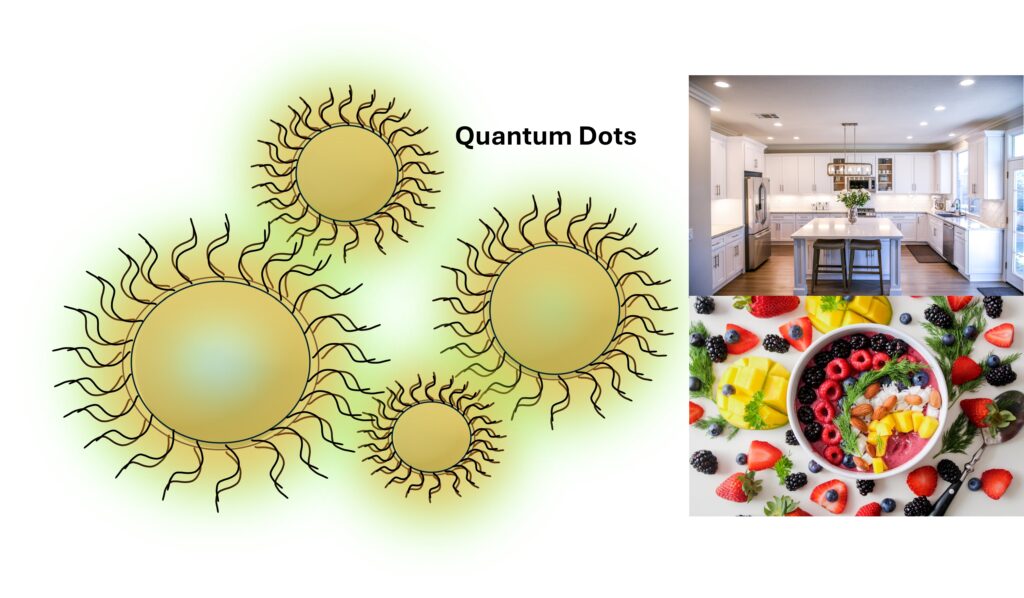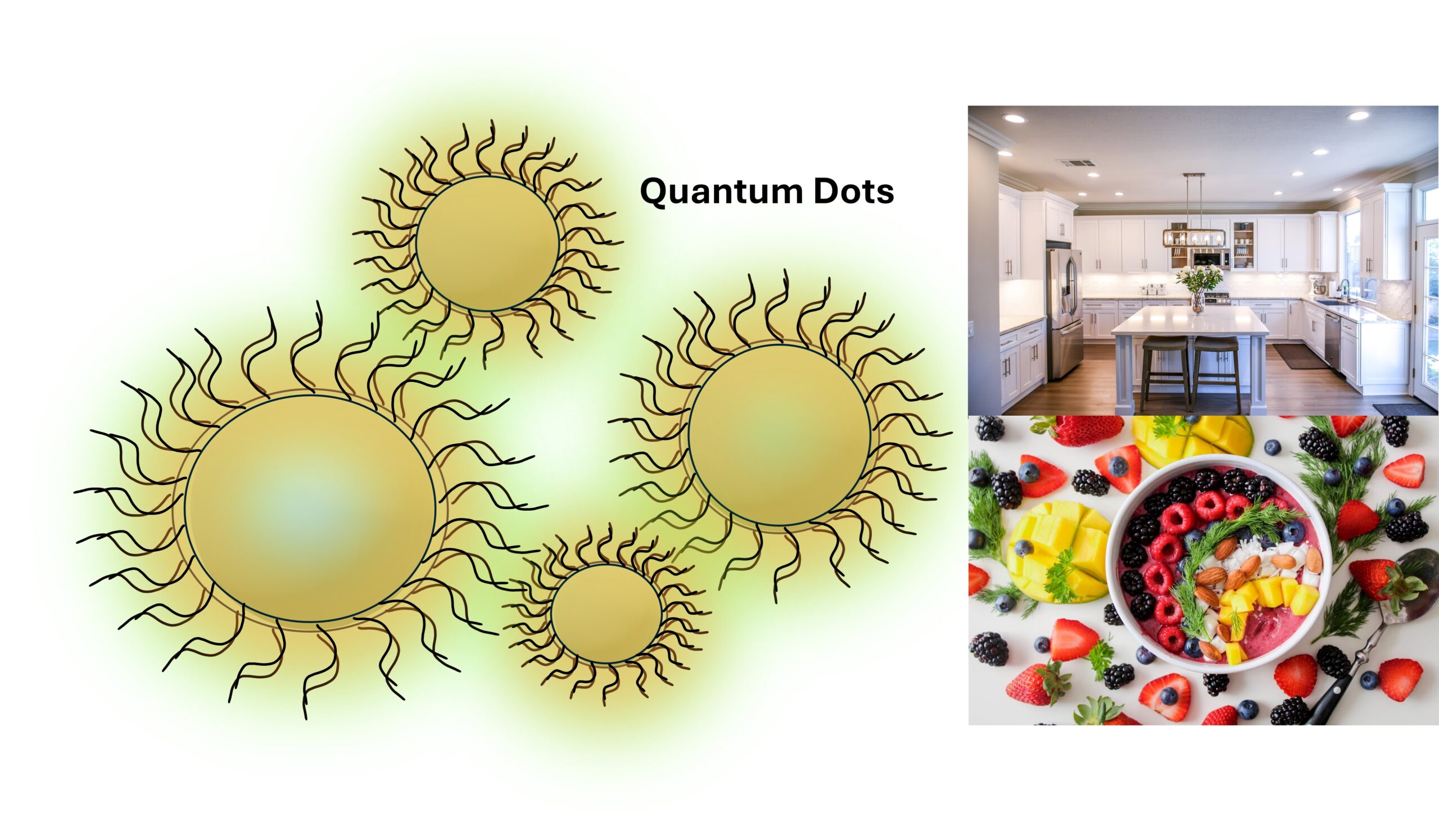Table of Contents

Abstract
Quantum dots have emerged as a key innovation in today’s fast-paced world, where the kitchen has evolved into more than just a space for preparing meals. As technology continues to advance, the concept of smart kitchens has gained momentum. Among the various cutting-edge innovations, one that stands out for its potential to improve safety is the use of quantum dots. These nanoscale semiconductor particles emit specific wavelengths of light, offering a range of applications. One of the most intriguing is their ability to create a “safety glow” in smart kitchens, enhancing daily household safety.
This article describes, how quantum dots are revolutionizing safety in smart kitchens, their scientific foundation, their applications, and the benefits they bring to everyday life.
What Are Quantum Dots?
They are tiny particles, only a few nanometers in size, with unique optical and electronic properties due to their quantum mechanical behaviour. Unlike traditional materials, it can absorb and emit light at specific wavelengths, depending on their size. This means they can be engineered to glow in different colors under certain lighting conditions.
Scientifically speaking, the ability of these dots to emit light is tied to the phenomenon of quantum confinement, where the movement of electrons is restricted to a limited space. As a result, these particles behave differently from bulk materials and offer highly tunable optical properties. The size of a quantum dot determines the energy gap between its electron energy levels, which in turn affects the color of light emitted.
How Quantum Dots Work in Smart Kitchens?
The application of quantum dots in smart kitchens revolves around their light-emitting capabilities. Imagine a scenario where kitchen utensils, countertops, or appliances embedded with quantum dots glow in response to specific stimuli. For instance, these dots can be integrated into surfaces or coatings, which then emit a glowing signal under ultraviolet (UV) or blue light, making potential hazards like sharp knives or hot stoves more visible in low light conditions.
Safety Alerts Through Color-Coding
One of the most innovative uses of these dots is color-coded safety alerts. Appliances embedded with it can change color to warn users of various risks. For example, stove handles can glow red when the surface is hot, or knives can glow brightly in low-light conditions to prevent accidental cuts. These subtle but effective visual cues can significantly reduce the risk of kitchen accidents.
Smart Labels for Food Safety
Another promising application is in smart labeling for food safety. By incorporating them into packaging or labels, it is possible to detect changes in food quality. They can change color in response to chemical changes, such as the breakdown of food molecules that indicate spoilage. This technology could prevent foodborne illnesses by alerting users when food is no longer safe to eat.
Smart Lighting for Workspaces
They are already being used in high-efficiency displays and lighting systems. In smart kitchens, they enhanced lighting could improve visibility, especially in areas where precision is critical, such as food preparation surfaces. With quantum technology, lighting can be customized to emit specific wavelengths that highlight potential dangers or improve task visibility.
The Science Behind Quantum Dots
At the core of quantum dots is their unique quantum mechanical behavior, which allows them to have tunable optical properties. They are usually made from semiconducting materials like cadmium selenide (CdSe), cadmium sulfide (CdS), or indium phosphide (InP). When light is absorbed by these materials, electrons in the quantum dots are excited to higher energy states. As these electrons return to their ground state, energy is released in the form of light.
The color of the emitted light depends on the size of the quantum dot: smaller dots emit light at shorter wavelengths (blue or green), while larger dots emit at longer wavelengths (red or orange). This tunability makes them particularly versatile for various applications, from displays to safety enhancements in smart kitchens.
Quantum Dots in Everyday Kitchen Use
While the concept of quantum technology in smart kitchens may seem futuristic, their integration into everyday kitchenware and appliances is already in progress. For instance, quantum dot coatings can be applied to countertops to create surfaces that glow under specific lighting conditions, making it easier to spot spills or contamination. These coatings can be engineered to highlight hazardous zones, ensuring that users can quickly identify risks and take action.
Benefits of Quantum Dots for Kitchen Safety
The primary appeal of these dots lies in their ability to improve safety in ways that traditional technologies cannot. Some of the key benefits are listed below.
1. Enhanced Visual Cues
They offer a clear, easily interpretable visual warning system. Their ability to emit vibrant colors under specific conditions ensures that users can identify potential risks without relying on traditional warning signals, such as alarms or text-based notifications.
2. Improved Efficiency
They are highly energy-efficient, requiring minimal power to function. This makes them ideal for integration into smart kitchen devices, where energy conservation is often a priority.
3. Durability and Longevity
They are stable and long-lasting, making them well-suited for continuous use in kitchen environments. Whether embedded in countertops, appliances, or utensils, they provide reliable safety enhancements without frequent maintenance.
4. Eco-Friendly
They are being developed using eco-friendly materials such as cadmium-free alternatives, like indium phosphide (InP). These newer versions ensure that the technology remains safe for both users and the environment.
Challenges and Considerations
While the potential of quantum technology in smart kitchens is vast, there are challenges to consider. First, the production of quantums can be expensive, though advances in manufacturing techniques are gradually reducing costs. Additionally, ensuring that the materials used in them are non-toxic is essential, especially in food-related applications. Cadmium-based quantum dots, for instance, pose environmental and health risks, which has driven the development of safer alternatives.
Another consideration is the need for consumer education. While the visual cues provided by these dots are intuitive, users may need guidance on how to interpret certain signals, especially when dealing with smart labels or food safety systems.
Future Trends and Developments
The future of quantum technology in smart kitchens looks promising, with researchers continually developing new ways to integrate this technology. Here are some potential future trends:
- Integration with Artificial Intelligence (AI): They could be combined with AI systems to create fully autonomous kitchen safety systems that detect hazards and alert users in real-time.
- Wider Use of Cadmium-Free Quantum Dots: As research into cadmium-free quantum dots advances, we can expect more environmentally friendly options that still deliver high performance.
- Quantum Dot Sensors for Air Quality: In addition to food safety, their sensors could monitor kitchen air quality, detecting harmful pollutants like carbon monoxide or volatile organic compounds (VOCs) from cooking.
Conclusion
They are an exciting and innovative technology that has the potential to revolutionize safety in smart kitchens. With their ability to provide clear visual warnings, enhance food safety, and improve workspace lighting, quantum dots are poised to become an integral part of the smart kitchen experience. As research continues and manufacturing processes become more cost-effective, it is likely that they will become increasingly accessible to everyday consumers.
Beyond the kitchen, the versatility of these dots suggests that their application could extend to other areas of the home and even industries like healthcare and automotive safety. For instance, their use in detecting contamination or highlighting critical areas of concern could lead to breakthroughs in personal safety and public health. The ability to integrate quantum dots with other smart home systems, such as artificial intelligence (AI) and the Internet of Things (IoT), further amplifies their potential impact.
However, it is important to address the challenges that accompany their adoption, such as ensuring eco-friendly materials and widespread consumer education on their usage. As industries overcome these hurdles, quantum dots are set to drive a significant transformation not just in the realm of kitchen safety but also in broader technological advancements.
Ultimately, quantum dots represent the future of interactive, intelligent, and safer environments. They will redefine how we interact with our everyday spaces, ensuring that safety is seamlessly integrated into the core of our daily routines. As we move forward, the combination of quantum dot technology with other innovations will create smarter, safer, and more responsive homes that align with our evolving technological needs.
Frequently Asked Questions (FAQs)
- What are quantum dots?
Quantum dots are nanoscale semiconductor particles that emit light in specific colors based on their size. - How do quantum dots improve kitchen safety?
Quantum dots provide visual cues through glowing surfaces or appliances, alerting users to potential dangers like hot stoves or spoiled food. - Are quantum dots safe for food-related applications?
Yes, but it is essential to use cadmium-free quantum dots in food-related applications to avoid toxicity. - Can quantum dots be used in kitchen lighting?
Yes, quantum dots can enhance kitchen lighting by providing customized light wavelengths that improve visibility and safety. - What are the challenges of using quantum dots in kitchens?
Key challenges include production costs, ensuring non-toxicity, and consumer education on interpreting visual cues. - How long do quantum dots last?
Quantum dots are durable and can last for years without significant degradation in performance. - Are quantum dots eco-friendly?
Cadmium-free quantum dots are being developed as eco-friendly alternatives to traditional versions. - Will quantum dots become common in all smart kitchens?
As technology advances and costs decrease, it is likely that quantum dots will become more prevalent in smart kitchen applications.
References
https://pmc.ncbi.nlm.nih.gov/articles/PMC2858563
https://www.azonano.com/article.aspx?ArticleID=6621
https://www.nature.com/articles/s41377-020-0268-1
https://pmc.ncbi.nlm.nih.gov/articles/PMC10290018
https://www.mdpi.com/2304-8158/12/11/2195
https://www.mdpi.com/1996-1944/14/24/7732
https://www.mdpi.com/1422-0067/23/8/4088
https://www.mdpi.com/1420-3049/28/14/5604
YouTube video Linkhttps://youtube.com/shorts/Z4omcmcsNtE?feature=share

